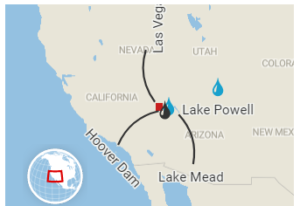In news- For the first time, the US government has declared a water shortage for the Colorado river basin.
Key updates
- As per the Bureau of Reclamation, which manages water and power deliveries, the release of water from two large reservoirs called Lake Mead and Lake Powell will be affected because of a historic drought that is impacting the entire Colorado river basin.
- Governors of ten western US states wrote to US President Joe Biden on August 15, requesting him to declare a Federal Emergency Management Agency (FEMA) drought disaster in these states.
Reasons for the shortage
- This Colorado River Basin has been experiencing a prolonged drought since 2000.
- The historic dry conditions have been exacerbated by recent record-setting temperatures.
- This persistent drought has led to lowering down of the water levels in the basin’s reservoirs to meet the demand over the years.
- There are two reservoirs at the centre of this water shortage. One is Lake Mead, located in the state of Nevada just a few miles from Las Vegas.
- Lake Mead is the largest reservoir in the US in terms of volume and was formed in the 1930s by the Hoover Dam in Southern Nevada.
- The other is Lake Powell, the reservoir created by the Glen Canyon Dam in Arizona.

- Over the last two decades, a sustained drought has been lowering the water levels in these two reservoirs.
- Even with a great water storing capacity, over the years the demand for water from the basin has increased whereas supply is restricted.
- The increasing demand is one reason that the levels of water in Lake Mead and Lake Powell have fallen.
Impact
- It will have implications for residents in southwestern US and some parts of northwestern Mexico starting October 2021.
- It will also impact farmers, industries, local communities and economies.
About Colorado River-
- It flows from the Rocky Mountains into southwestern US and into Mexico.
- Starting in the central Rocky Mountains of Colorado in Grand Lake, Colorado, the river flows generally southwest across the Colorado Plateau and through the Grand Canyon before reaching Lake Mead on the Arizona–Nevada border, where it turns south toward the international border.
- The river is fed by snowmelt from the Rocky and Wasatch mountains and flows a distance of over 2,250 km across seven states and into Mexico.
- The Colorado River Basin is divided into
- The Upper (Wyoming, Colorado, New Mexico, Utah and northern Arizona) and
- Lower Basins (parts of Nevada, Arizona, California, southwestern Utah and western New Mexico).
- The entire Colorado river system is managed with a series of dams and canals to regulate flood control, water conservation and hydropower benefits.
- In the Lower Basin, the Hoover Dam controls floods and regulates water delivery and storage.
Apart from the Hoover dam, there is the Davis Dam, Parker Dam and the Imperial Dam that regulate the release of water from the Hoover Dam.
















